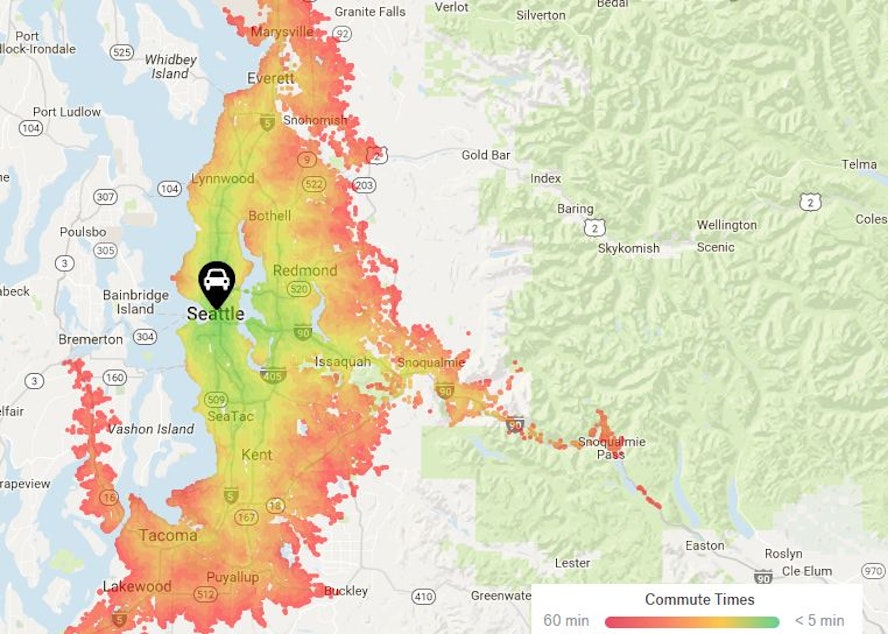Seattle's commute zone is a hot mass

About 236 people move to the Seattle area every day, according to the Puget Sound Regional Council.
This means more people driving to their jobs, some more than an hour. About 100,000 people commute to the region from Whidbey Island, Aberdeen, Mount Vernon and beyond, according to the regional council.
On the commute map produced by real estate company Trulia, above, red indicates an hour commute. That seems optimistic. Marysville is in the red zone, but at rush hour it’s easily an hour and a half from Seattle. That’s because Highway 2, which serves suburbs east of Everett, funnels overwhelming traffic into I-5. Also, more than a dozen train crossings slow commuters moving through Marysville.
We’ll find out how packed we’ve become in June, when the state works up the numbers. They believe the population hit 4 million last year; it’s supposed to reach 5 million by 2040.
We’re booming because of a thriving tech sector and well-paid jobs. The wealth isn’t being spread around evenly, though, which causes stress for tenants and hopeful homebuyers. Rents have soared, and housing prices have done the same – each driven by too much demand and too little supply. It hasn’t been easy for people whose incomes have not kept up with the rise in the city’s fortunes. Many are moving far into the suburbs for a lifestyle they can afford.
Sponsored
More rental housing is moving onto the market in 2017, but more people are on the way. Freeway delays are increasing, according to the state transportation department; a light rail system that could relieve pressure is a dozen years away.
It’s stressful, but you adapt, says Mark Hallenbeck, transportation researcher at the University of Washington. He points to the City of Seattle’s decision to turn a lane of Denny Way into a bus-only lane.
“When the buses are way more efficient, it becomes way more palatable to take those, so people will shift to do that,” Hallenbeck says. “Those kinds of changes are taking place.”
Hallenbeck also says people will learn to adjust to life in our more-demanding metropolis. They'll exploit improvements in public transit. They'll exchange big houses for smaller ones in the right location.
“People will choose not to live in a four-bedroom house when there are only three of them,” he says. “All you’re doing is changing what you value.”
Sponsored
As we adapt, maybe we can come up with a new name for our transforming region. “Puget Sound” doesn't capture the region's eastern expansion. “Seattle area” misses the major job centers on the Eastside, and in Everett and Tacoma.
We’re partial to “hot mass,” but that’ll soon be dated.
What are your ideas?
Carolyn Adolph can be reached at cadolph@kuow.org. Have a story idea? Use our story pitch form.
